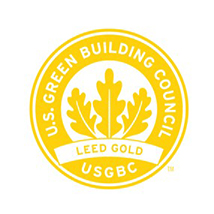At Carter’s, we believe in contributing to a better future for generations to come. We also recognize the emerging risks that climate change can pose for people and businesses everywhere. To do our part in leaving behind a world where our children can thrive, we and our industry must continue to reduce the environmental impacts of our products and operations.
Over the years we have launched a number of initiatives intended to reduce our overall environmental impact while also improving operational efficiency. Through this strategy, we have made significant progress in reducing the energy we consume, the emissions we generate, and the waste we send to landfills. We have also established a company environmental policy that will guide our management of impacts and resources in the future. While we are proud of the progress we have made, we continue to search for new opportunities to lessen our impacts, and we look forward to sharing our progress in this area over time.


Carter’s LEED Gold Certified Corporate Headquarters
In 2013, we moved our corporate headquarters to an Atlanta office building where we currently occupy approximately 300,000 square feet. To minimize the impact of the new space, we designed the offices to meet LEED Gold and Energy Star Certifications, which guided us in making sustainable choices that maximize energy efficiency and other environmental benefits. Thanks to the new design, we reduced energy consumption of our headquarters by 20% compared to our previous corporate office. We also applied LEED requirements to reduce the impact of the office’s construction, and recycled and repurposed 99% of all construction waste.
Improving Our Energy and Emissions Footprint
We recognize the importance of taking action to reduce greenhouse gas (GHG) emissions, both for ourselves and for the generations that follow us. To establish an objective understanding of our impacts and opportunities, we conducted our first-ever environmental inventory in 2019 (based on 2018 data), which has helped us to better understand our energy, water and waste footprints across the entire business.
Based on our findings, we have committed to reducing our GHG emissions by at least 25% by 2030. We plan to share more details about this goal in 2021. In the years ahead, we also intend to implement, track, and report on a variety of initiatives designed to lower our overall environmental impacts.
Energy efficiency has been a focus of ours for many years. For example, we have made large-scale lighting upgrades in both our distribution centers and retail locations, phasing out halogen and fluorescent bulbs in favor of brighter and more efficient LED fixtures. We have also installed programmable and smart thermostats at some of our retail stores, which save energy while lowering cooling and heating costs.

Reducing energy consumption is not the only way we have reduced our GHG emissions. For example, we outfitted of the forklifts in our largest distribution center with hydrogen fuel cells instead of lead acid batteries, which reduced forklift emissions by 73%. However, over 70% of our GHG emissions come from the operations of our vendors. While we do not have direct control over those emissions, we intend to engage in the coming years with our vendors to identify opportunities for improvement.
Improving Shipping and Logistics Efficiency
Over the last ten years, we launched several projects to streamline both the upstream and downstream logistics of our operations. These projects have included:
- Increasing the number of units per shipping container.
- Streamlining shipping routes.
- Increasing our use of rail transportation.
- Optimizing the loading and unloading of trailers at our distribution centers.
Together, these projects have resulted in GHG emission reductions while making our transportation and distribution more cost-effective.
As part of our ongoing effort to improve our energy and emissions footprint, we are collecting and analyzing data about our operation so we can measure and improve our energy footprint.
| Energy (thousand MWh) | 2018 |
|---|---|
| Total energy consumption from operations1 | 165,077 |
| Energy intensity (thousand MWh per square foot)2 | 0.02 |
GHG Emissions (metric tons CO2e) |
|
| Total absolute emissions3 | 217,176 |
| Scope 1 emissions4 | 6,522 |
| Scope 2 (location-based) emissions5 | 53,402 |
| Scope 2 (market-based) emissions6 | 56,171 |
| Scope 3 emissions7 | 157,253 |
| Emission intensity (metric tons CO2e per million in net sales) | 62.73 |
| Emission intensity (metric tons CO2e per million units produced) | 264.82 |

- Operations refers to those directly controlled by Carter’s. Values includes purchased electricity. Sources the same as those listed in "Scope 1 emissions", as more fully discussed in Footnote 4, below.
- Included in this number are operations directly controlled by Carter’s, which include: US retail stores, US corporate offices, US distribution centers (DC), Canada retail stores, Canada corporate office, Canada DC, Asia DC, Mexico retail stores, Mexico corporate office, and Mexico DC.
- Value is calculated using location-based "Scope 2 Emissions", as more fully discussed in Footnote 5, below.
- "Scope 1 emissions" are direct emissions from sources that are owned or controlled by Carter’s. This value includes: use of fuels such as natural gas, diesel, propane, etc., and fugitive emissions in the following manner: US Stores (90% actual utility values provided by Siemans, 10% estimated based on square footage); US Corporate (actual utility values); US DCs (actual utility values provide by Siemans and NFI Industries (Chino)); Canada Stores (81% actual utility values provided by Siemans and 19% estimated utility values based on square footage); Canada Corporate (actual values provided by the utility); Canada DC (actual values provided by the utility); Asia DC (combination of actual utility invoices and estimations); Mexico DC – (no fuel usage data is available).
- "Scope 2 (location-based) emissions" are indirect emissions from sources that are owned or controlled by Carter’s, and values are derived directly from the location. Values only include purchased electricity. Sources the same as those listed in "Scope 1 Emissions", as more fully discussed in Footnote 4, above.
- "Scope 2 (market-based) emissions" are indirect emissions from sources that are owned or controlled by Carter’s, and values are derived for a location based on market data. These data supplement the Scope 2 (location-based) emissions data. Value only includes US facilities (i.e., US Stores, US Corporate, US DCs) and excludes purchased electricity. Market emissions factors are not available for many international facilities. For some facilities in the US, no market-based factors were found. In these cases, we utilized location factors (eGrid) as a proxy.
- "Scope 3 emissions" are from sources not owned or directly controlled by Carter’s, but related to Carter’s activities. Value includes: outsourced shipments and distribution from international and domestic third-party logistics partners, calculated emissions from Carter’s top 20 vendors in 2018 (note that these top 20 vendors have not been scaled up to account for all vendors based on total calendar year production), life cycle emissions related to water sourcing and municipal wastewater processing, and life cycle emissions of waste generated by Carter's DC operations and sent to landfill.

